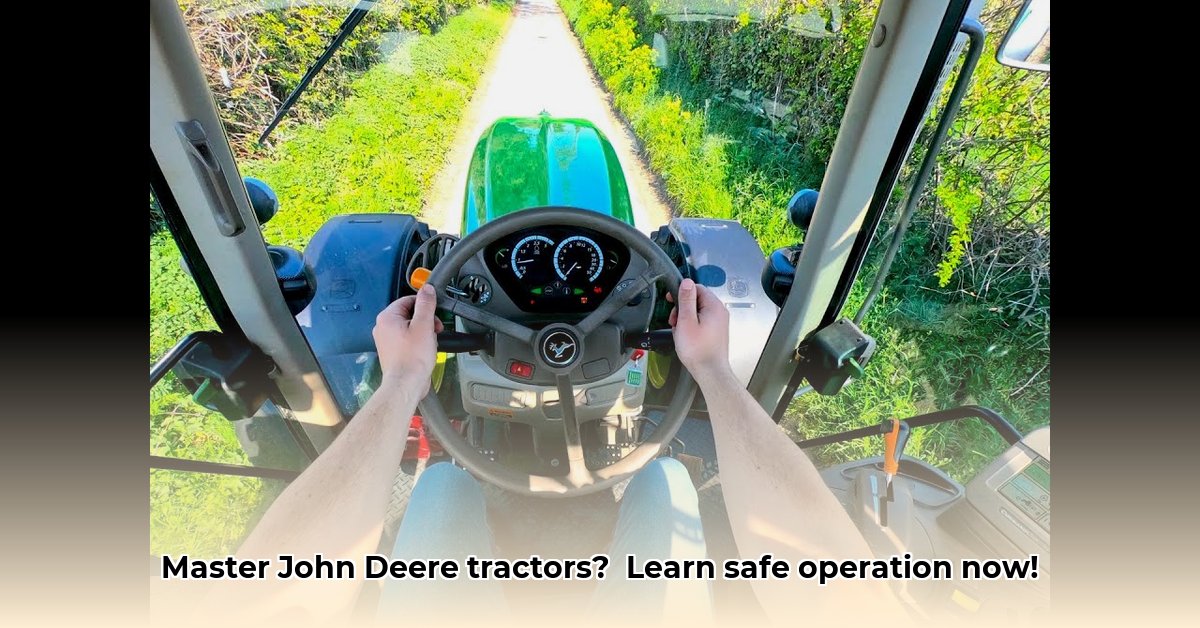
How to Operate a John Deere Tractor Safely
Operating a John Deere tractor requires skill and a strong commitment to safety. This guide provides a step-by-step approach, emphasizing preventative measures and safe operating procedures. Remember: Your safety is paramount. Always consult your tractor's owner's manual for model-specific instructions and safety guidelines. To locate your tractor's serial number, see this helpful guide.
Pre-Flight Checklist: Preparing Your John Deere for Safe Operation
Before starting the engine, perform a thorough pre-flight check. This preventative maintenance significantly reduces the risk of accidents and costly repairs. Failing to do so is a serious safety hazard.
Check Fluid Levels: Inspect engine oil, transmission fluid, hydraulic fluid, coolant, and fuel levels. Low fluids can lead to engine damage or malfunction. (Add fluids as needed. Never operate with low fluid levels.)
Tire Pressure: Properly inflated tires maintain stability and prevent rollovers. (Check tire pressure and inflate as needed. Under-inflated tires are extremely dangerous.)
Brake Test: Thoroughly test the brakes. (Ensure brakes are responsive and reliable. Faulty brakes are a critical safety hazard. Do not operate with faulty brakes.)
Steering System Check: Verify smooth and responsive steering. (Report any unusual looseness, stiffness, or noises to a qualified mechanic. Impaired steering compromises control and increases risk.)
Attachment Inspection: If using attachments (plow, mower, etc.), ensure they are securely attached and in good working order. (Loose attachments can become projectiles, causing serious injury.)
Lights and Signals: Confirm proper functioning of lights and turn signals for visibility, especially near roads or other vehicles. (Malfunctioning lights reduce visibility and increase accident risk.)
ROPS and Seatbelt: Verify that the Rollover Protective Structure (ROPS) is in place and securely fastened. Always wear your seatbelt. This is your primary defense against injury in a rollover. (Failure to use the ROPS and seatbelt is a critical safety hazard.)
Operating Your John Deere: A Step-by-Step Guide
With pre-flight checks complete, proceed with these operational steps:
Starting the Engine: Engage the parking brake firmly. Then, follow the starting procedure in your owner's manual. (Never start the engine without engaging the parking brake.)
Gear Selection: Choose the appropriate gear for the job and terrain. Use lower gears for heavy loads or steep inclines. (Improper gear selection can lead to stalling, loss of control, and damage.)
Gentle Acceleration: Accelerate gradually, avoiding jerky movements. (Sudden acceleration reduces control and increases risk.)
Power Take-Off (PTO): Engage the PTO only after the implement is secured and the tractor is moving at a safe speed. Disengage before dismounting. (Improper PTO use can cause serious injury.)
Operating Attachments: Follow implement-specific instructions, paying attention to speed and depth settings. (Incorrect settings can lead to inefficient operation or damage.)
Safe Maneuvering: Exercise caution when turning, especially on slopes. Make smooth turns, avoiding sudden movements. (Sudden turns, particularly on slopes, are a common cause of rollovers.)
Safe Stopping: Reduce speed gradually before stopping completely. Engage the parking brake when parked. (Leaving a tractor unattended without the parking brake engaged is hazardous.)
Safety Considerations: Awareness and Terrain
Operating a tractor on slopes significantly increases the risk of rollovers. Proceed with extreme caution and always assess the terrain before beginning work. Never underestimate the dangers of uneven ground. Remember – even a seemingly small ditch can cause a tractor to tip.
Crucially: Never allow passengers on the tractor. This is a leading cause of serious accidents.
Tractor Maintenance: A Foundation of Safe Operation
Regular maintenance is vital for both safety and longevity; it is not optional. A well-maintained tractor is a safe tractor. Refer to your owner's manual for a detailed maintenance schedule.
| Maintenance Item | Recommended Frequency | Importance |
|---|---|---|
| Engine Oil Change | Every 50-100 hours | Prevents engine wear and ensures smooth operation. |
| Fluid Level Checks | Before each use | Prevents breakdowns and malfunctions. |
| Tire Pressure Checks | Weekly or before each use | Maintains traction and stability; crucial for safety. |
| Brake Inspection | Before each use | Ensures safe and reliable braking. |
| Attachment Inspections | Before each use | Prevents malfunctions and safety hazards. |
This comprehensive guide provides foundational knowledge. Always refer to your John Deere operator's manual for detailed instructions specific to your model. Safe tractor operation requires constant vigilance and a strong commitment to safety. Your safety, and the safety of those around you, depends on it.